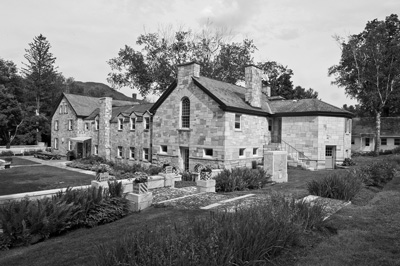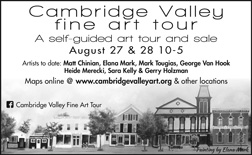Arts & Culture August 2016
Amid cool marble, a hotbed of creativity
Dorset estate finds new life as retreat for artists
 By KATE ABBOTT
By KATE ABBOTT
Contributing writer
DORSET, Vt.
The Marble House Project has transformed a massive old home in Dorset, Vt., into a retreat for visual artists, dancers, musicians, writers and other creative people. Eight artists at a time share three-week residencies at the property from May through October and regularly share their work with the public. George Bouret photo
Lara Palmquist usually works in a cabin without electricity, but on a sweltering afternoon she had set up a standing desk and a balance board in a quiet, spare studio room.
She was beginning work on a novel set in Svalbard, Norway, researching threads of a story that revolves around environmental science and her background in biology.
Up the hill, Kira Nam Greene had covered another studio wall with bright squares and painted patterns inspired partly by the architecture of this place: a broad gabled house made of marble quarried on the land behind it.
Palmquist and Greene spent three weeks in July as artists in residence at the Marble House in Dorset. Eight artists at a time share residencies from May to October, said Sarah Walko, the retreat’s director of arts programming.
The Marble House Project, which opened gently three summers ago, has expanded rapidly, bringing in visual artists, dancers, musicians and writers, creative people from many backgrounds and parts of the world. This summer, the retreat has begun reaching out to the community.
The artists cook their evening meals with food from the property’s gardens, beehives and a chicken coop on wheels. They visit local museums and farmers markets. And they give public talks, performances and open studios on Tuesday nights.
Beyond that simple structure, they are free to work and to wander, Walko explained. Artists selected for the program face no charge for their three-week stay beyond transportation and out-of-pocket expenses; the program is supported through donations and grant funding.
The visiting artists live in the marble house itself. The quarry’s owner built the original house about 1820 with his own stone, and in 1915 the journalist, writer and diplomat Edwin Lefevre added an extension and formal gardens with a fountain, steps, planters, benches and colonnade.
Higher on the hill, 48 acres encompass farm gardens and barns, studio buildings and a stone-lined pool with water deep green from the marble.
Trails cross an upper meadow with “I dwell in possibility” written in birch poles against the sky. The line from Emily Dickinson was made part of an installation by a former resident, Kathy Bruce.
Still higher, tumbled, massive stone blocks mark the old quarry, with a natural pool for fish and turtles, and a marble cabin National Geographic built here for an episode of its “Building Wild” series that aired last year.
The artists sometimes gather at the quarry on warm nights, Walko said, around a massive marble table with a metal fire bowl.
Realizing a long-held dream
This historic summer home and wild and cultivated land, this blend of art and agriculture, belongs to Danielle Epstein, who co-founded the Marble House Project with Dina Schapiro. (They are now president and treasurer of the organization’s board.)
“It was a 25-year dream of Danielle’s to start a residency program,” Walko said.
Epstein is also an artist and had an intense experience in a residency program as a young woman.
“I wholeheartedly like the salon idea,” she said, “and I’ve done it all my life -- people coming to dinner, artists talking together. This is an expansion.”
By the end of this year, more than 150 artists will have lived and worked here, she said.
They also will have worked on the land. The artists can plant and learn tasks in the garden, Walko said, and much of what they eat here grows here.
Marble House has two bee colonies and 14 chickens. Among the garden beds she pointed out squash, tomatoes, pumpkins, wildflowers for the bees, eggplant and peppers, garlic and kale, carrots and potatoes.
This summer, under Tina Cohen, the retreat’s director of sustainable agriculture and horticulture, the Marble House is offering cooking workshops with whatever is ripe in the garden.
The artists have picked herbs and cooked for the group, walked on the trails, gone running on the back roads and worked at their own pace.
Palmquist said she welcomed that freedom in an atmosphere that let her work grow organically.
“I can let it be messy,” she said.
She was just starting her novel, with no pressure to present, no one asking to see her early drafts. She could reach and risk and get close to the material, she said. She could pay attention to associations and resonances.
She had space and freedom for wool gathering and weaving, and with a novel so rough and so much in the stage of experimenting, she needed that room to breathe.
“It’s rare to be able to sink in,” she said. “When I come up from work, for a moment I have to recalibrate being in this world, and that’s wonderful.”
Palmquist routinely writes in longhand until the final draft, paying attention to rhythm and sounds of the words. Here she could talk about her work with other artists in residence, clarifying information absorbed over a day of research. She said she had not often spent time in writing workshops, and the experience of working in a close community of creative people was new to her.
“It feels like a found family,” she said. “We listen to each other speak, and in speaking about it we refine our work.”
She found it helpful to talk with people who let her work through ideas without flooding her with suggestions. Others who are deeply involved in their own projects can relate.
“I have so much motivation to tell this story,” Palmquist said. “And I want to keep the urgency to say it on the page.”
Telling others about it “taps into that urgency,” she said.
“The meals are important,” Palmquist said. “I like that we cook them together. It’s something we create, and it’s done every night -- done and enjoyed. It’s a complement to larger projects that require endurance. I’m surprised how sustaining that has been.”
Finding inspiration
Greene likewise said she felt a strong connection from being among a group of people who wanted her to succeed, and she also cited the warmth of the communal dinners.
The people she met here are accomplished, articulate and generous, she said, and she enjoyed talking with them and understanding their artistic practices -- composers, writers, playwrights, all adjusting to a new space and new ways of working.
In her studio, Greene had formed bright patterns like a mosaic of stencils, and paint dripped in bright colors down the wall. The marble planters in the formal gardens inspired some of these shapes, with their geometric symmetry and fabulous monsters, she explained. Greene designed her own creatures in that style, and the house itself inspired more.
Greene said she had never seen brick or marble used like this -- rectangular stone in the newer part of the house and rougher-cut stone in the older part, which looked free-hand to her, not at all planned, just built it as it was built.
She planned to add natural elements, ferns and flowers, to her creations.
Greene’s recent work often incorporates wall drawings, she said. She is drawn to images that invoke women’s lives and desires, like still lifes of rounded fruit and patterns in wallpaper, and to decorative aret forms that historically have stayed at the margins of Western art.
In the past, wallpaper designers were considered crafters, not artists, she said. But since the 1970s, a growing movement in the United States has brought many crafts, including glassblowing, woodworking and ceramics, into the world of fine art. She would like to be part of that movement.
Greene said she is interested in patterns and the cultural influences they reveal. She lives in New York City and came to the United States from Korea. As an immigrant, she is drawn to explore cultures influencing each other.
European artisans in the 18th-century designed wallpapers with fancy flower motifs and sent their drawings to crafters in India and China to embroider them. The Asian artists and artisans would quietly add in their own designs, and the European designers would adopt those elements in their own new patterns.
This mixing of cultures feels familiar in the way she lives here, Greene said. In the city, she has friends from many places. And the mix of disciplines and art backgrounds at the Marble House enlivened her work, as the place itself has done.
“It has been so wonderful here -- a paradise,” she said.
Greene has a studio in Brooklyn, in an industrial part of the city, and in Vermont she relaxed into long days walking around the gardens and taking photographs, shaping new patterns inspired by plants and swimming in the marble pool. She needs a lot of light, so working in her studio under the lamps can get hot on a humid, thundery day.
“I don’t want to leave,” she said.
Schedule of upcoming events
Public events scheduled this month at the Marble House in Dorset include:
• ArtSeed open studios, Tuesday, Aug. 2, with Lien Truong (paintings exploring culture, history and belief), Christopher McNulty (sculpture, video and works on paper) and Dempsey Rice (photography reflecting mother-and-daughter themes).
• Culinary workshop, Thursday, Aug. 4, focusing on pasta making.
• Garden tour with buffet lunch, Sunday, Aug. 7.
• ArtSeed, Tuesday, Aug. 9, with performance by Wendy Rein and Ryan Smith of RAWdance.
• Farm-to-table dinner, Saturday, Aug. 13.
• ArtSeed, Tuesday, Aug. 16, with composer and flutist Zach Sheets.
• Culinary workshop Aug. 18, with a theme of improvisational cooking.
• ArtSeed, Tuesday, Aug. 23, with readings by novelist and nonfiction writer Cris Beam (author of “To the End of June: The Intimate Life of American Foster Care,” “Transparent: Love, Family and Living the T with Transgender Teenagers”) and fiction writer Fatima Mirza, a fellow and teacher at the Iowa Writers’ Workshop
• ArtSeed, Tuesday, Aug. 30, with dancer and performance artist Coco Karol followed by open studios with Kyle Peets (printmaker and sculptor), Samantha Holmes (mosaic artist), and Gowri Savoor (visual artist with environmental sculpture, works on paper and the Indian art of Rangoli).

